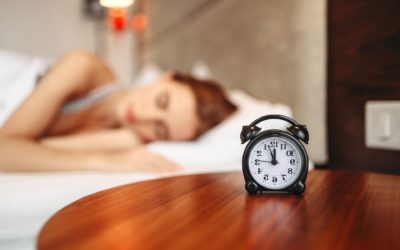Humans have, over thousands of years of evolution, also developed circadian rhythms closely tied to the seasons and the rising and setting of the sun and for most people, circadian rhythms result in a 24-hour sleep/wake cycle. However, our circadian rhythms are easily influenced by outside factors, including temperature and light exposure.
Indoor electricity has turned this evolutionary relationship with the sun on its head – we now see social jet lag and circadian disruption in 87% of day-working people. Specifically, the blue light found in lightbulbs and electronic devices exposes us to far more blue light than we would receive late in the day if we were only using sunlight as our light source, and in many instances this can throw our circadian rhythms out of balance. What also contributes to circadian disruption is the fact that we spend more time indoors than ever before — this means we’re also not getting the natural lighting cues our internal clock needs to keep our bodies on time. It’s not surprise that the downstream effects of this disruption are destructive — disorganized body clocks are believed to influence everything from obesity to insomnia to cancer risk.
If you’re fitness-focused, what you need to know is that light exposure can have a large impact on your holistic health and it even impacts the very effectiveness of your workouts.
Healthy Fitness Life Routine with Circadian Rhythm

The first step to regaining control of your circadian rhythm and using it to fuel your fitness, is to take charge of your lighting situation. Humans are no longer continually exposed to the natural cycle of the sun, and so, if you’re going to reap the benefits of a healthy circadian rhythm, you need to commit to some changes.
The first is easily within your control — consider your access to blue light. You want to ensure that you are waking up to blue spectrum light — this kicks your body clock into gear by releasing a hormone called cortisol and tells your brain to wake up!
Next, you need sustained exposure to that blue light throughout the day (more about this later in the article). In the evening, you need to wind down with warmer, amber or red-spectrum light, which induces the production of melatonin — the hormone that makes you sleepy and prepares your body for sleep. It is also important to put down all digital distractions at least an hour before bed since they emit blue light and stimulate your brain, both of which can negatively impact your sleep.
A healthy sleep schedule is vital to an effective workout — you need at least 8 hours of sleep each night, this allows your body the time it needs to make important repairs. But its not just duration of sleep, but timing as well. You need to sleep at the same time each day to get the most out of that sleep to repair and restore your body. Without proper sleep, your body can’t build muscle or support your general level of fitness! To reach those all-important 8 hours of sleep, it is important to create a lighting routine that gives you plenty of time to unwind. If you neglect your sleep, you might also experience excessive hunger. Which leads us to the importance of meal timing.
Schedule Meals Based on Circadian Rhythm

Creating a truly effective circadian rhythm boosting routine that supercharges the effectiveness of your workouts isn’t just about light exposure and sleep habits — you also need to think about when you eat. With a strong lighting schedule, you will notice your circadian rhythm will also affect your appetite. Specifically, when you get hungry and when your metabolism works best. This isn’t just about burning fat, but how your efficiently your body is using the nutrients you’re giving it — vital information for any fitness buff to have. Hunger cues and metabolism are driven by the hormones ghrelin (an appetite stimulant) and leptin (an appetite suppressant), both of which are affected by sleep!
A healthy light schedule and strong sleep habits will help you control hunger, but it is also important to stick to a regular meal schedule. The influx of nutrients stimulates hormone production which influences your body clock, metabolism, and general fitness.
This is one of the reasons scientists recommend you don’t skip breakfast. Skipping breakfast can trick the body into slowing its metabolism, increasing the long-term risk of insulin resistance and contributing to obesity.
What does a meal schedule based on circadian rhythms look like? Scientists who study diet and circadian rhythms recommend eating within 12 hours during the day. This includes breakfast and lunch as the larger meals of the day and eating a smaller dinner. They also suggest eating breakfast within two hours of waking up, and focusing all meals on key nutrients like protein, fiber, and healthy fats.
This circadian-based routine — light, sleep, meal timing — reinforces a healthy circadian rhythm and allows you to maximize the benefits you receive from the natural rhythms of your body, especially when it comes to your workout!
When to Work Out for Maximum Effectiveness
First, scientists suggest working out before you eat anything, first thing in the morning. This is when your body is flooded with human growth and cortisol hormones, making an early workout extra effective. There is even some evidence that working out in the morning dampens your appetite throughout the day, making calorie counting that much easier. Early workout times also tend to make us want to sleep earlier in the evening — giving us more time to rest, entrenching a healthy and natural circadian rhythm, while boosting our fitness even further!
If morning workouts aren’t for you, shoot for early afternoon — you’ll have a bit more energy thanks to having already eaten breakfast and you’ll still reap many of the same fitness rewards — just make sure you’re not scheduling late afternoon/evening workouts as those may impact your sleep.
The coolest part about working out is that it creates a positive feedback loop when it comes to circadian rhythm. There is evidence that shows exercising regulates the release of vital hormones and neurotransmitters, like serotonin and neuropeptide Y, that help your body clock function properly.
A Suggested Circadian Rhythm Workout (Diet and Sleep) Routine
We’ve thrown a lot at you, so let’s sketch out the important areas that will help you build a life/workout routine that focuses on supporting your circadian rhythm so you can take full advantage of all the benefits!
- Light Schedule: Ensure you have time-appropriate light exposure throughout your day, including early morning and daytime access to blue light (whether you get this via a sun lamp or waking up to natural daylight) and nighttime exposure to dim red or dim amber light (there are plenty of nighttime lights available for the home, some of which we’ll discuss below).
- Sleep Schedule: Sleep and wake on a regular schedule, most importantly, be sure you’re getting at least 8 hours of solid sleep.
- Workout Schedule: Workout first thing, before breakfast! Focus your morning workouts on aerobic exercises, these release endorphins that contribute to wakefulness and alertness. It also boosts your body temperature, which further increases alertness. If you plan to do heavy lifting or other weight training exercise, consider a mid-morning workout — 2 or so hours after breakfast.
- Meal Schedule: Stick to a healthy diet and meal schedule! This means prioritizing protein, vegetables, healthy fats and fiber, while striving to eat more calories for breakfast and lunch and a less calories for dinner.
Lighting Solutions for the Home
We’ve focused a lot on the importance of proper lighting when it comes to encouraging a healthy and natural circadian rhythm. So, let’s dive into some lighting product solutions!
For daytime, we know we need proper daytime blue light exposure. One solution is using blue-light emitting bulbs like the BIOS SkyBlue™ A21 LED bulb, it has the same wavelengths as sunlight during a 24-hour period. Install SkyBlue lightbulb in bedrooms (especially in lamps you use in the morning), home offices, and kitchens to improve your daytime alertness and wakefulness.
In the evening, BIOS Nightfall A19 LED lightbulb is perfect for nighttime and can be used in bedside table lamps to promote sleep initiation. Nightfall A19 also supports healthy sleep by reducing blue light up to 700% — helping to create a calm, tranquil evening atmosphere to that eases you into your sleep routine.
Conclusion
We’ve talked about how different habits and practices interplay with one another when it comes to our circadian rhythms — from light exposure to sleep time and when we exercise, we can continually make decisions that will allow us to gain the most benefit possible from our circadian rhythm — especially when it comes to fitness!
We’ve talked about the importance of building different habits, practices and routines and how those work together to support our circadian rhythms — from light exposure to sleep and being mindful of when we exercise, we can continually make daily decisions that allow us to maximize the benefits of our circadian rhythm — especially when it comes to fitness!
FAQs:
How does my circadian rhythm impact my workouts?
Your circadian rhythm dictates a lot of body processes, all of which can impact your workout! From metabolism to wakefulness, circadian rhythms shift throughout the day. It’s important to regulate your rhythm via good habits to ensure you’re getting the most from your workout.
How can light exposure impact my workouts?
Humans are primed by their circadian rhythm to be most active mid-morning to early afternoon; proper light exposure ensures this cycle. The more bright light and blue-spectrum light you receive during the day, the more alert you are. This means, working out during mid-morning to early afternoon with a properly regulated your body clock, you’ll be able to give more at each workout and get the most benefit from your workouts too!
How can mealtime impact my workouts?
Our circadian rhythm influences when we feel hungry and, in-turn, eating influences the circadian rhythm itself. Sticking to a consistent mealtime schedule reinforces a healthy pattern for your circadian rhythm and eating at different times of the day, in different amounts, can throw your metabolism out -of-whack, which is the last thing you want when you’re trying to get the most from your workouts! A set mealtime schedule will improve your metabolism and increase the fat-burning effectiveness of your workouts.
How can my sleep habits impact my workouts?
Aside from the obvious (who can workout well when they’re tired?), proper sleep hygiene also impacts our metabolism and wakefulness. Having a proper sleep schedule helps ensure your workouts are effective.
What is the best time of day to work out?
Morning is the best time, followed by early afternoon. These times are when humans are historically most likely to receive large amounts of bright, ‘blue sky’ light.


